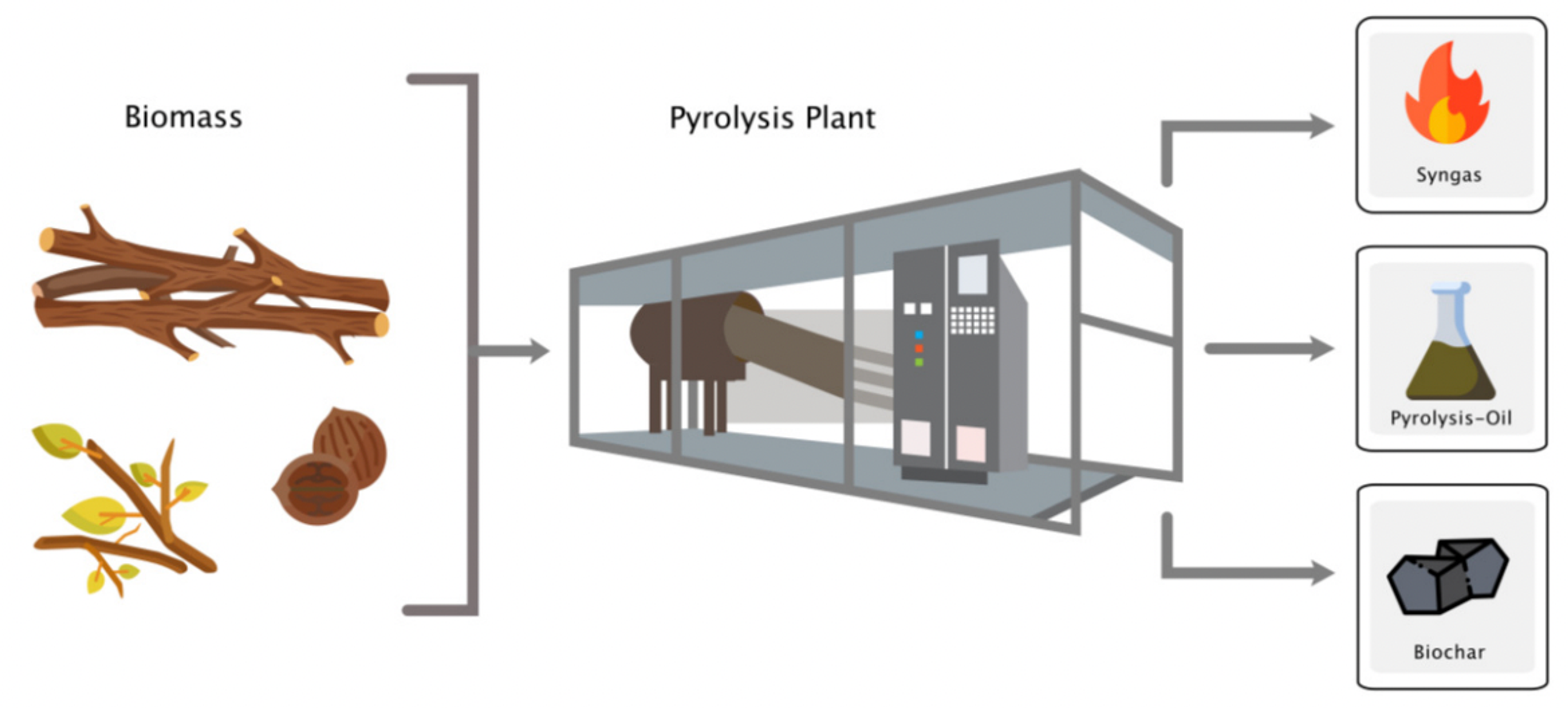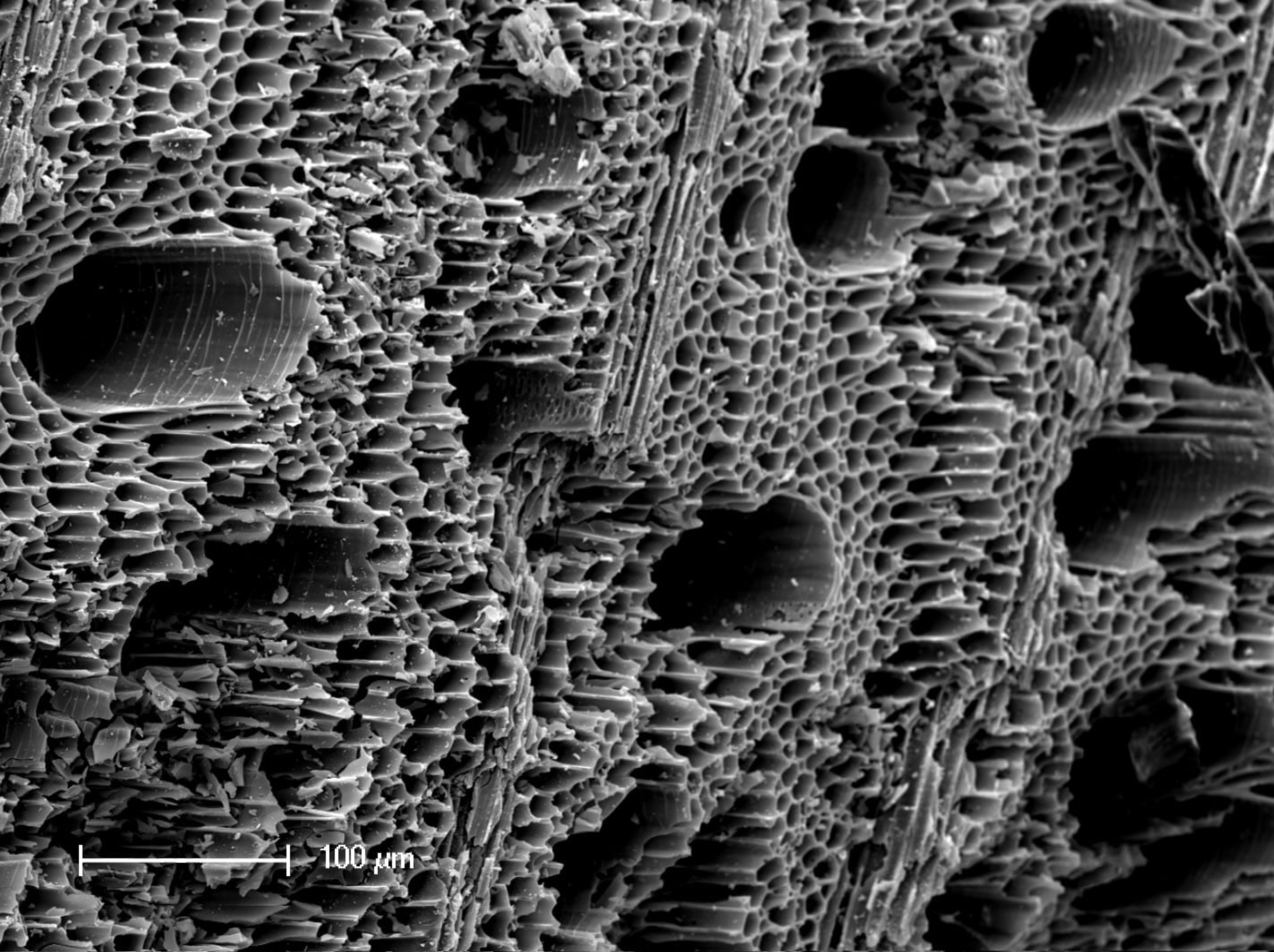Bringing carbon dioxide back to pre-industrial levels will be no easy feat, requiring significant sector decarbonisation and expanded durable carbon dioxide removal. Biochar has recently attracted much interest and support due to its considerable climate mitigation potential. Additionally, the co-benefits of biochar are far more significant than some high-tech carbon removal technologies (e.g., direct air capture) and positively impact the environment beyond solely carbon.
In this article, we look at biochar carbon offsets, applications of biochar, and the risks associated with such carbon-offsetting projects.
Biochar definition
Biochar is a porous and carbon-rich material produced by the pyrolysis of biomass feedstocks, including purpose-grown and waste biomass (e.g., agricultural, municipal, and timber waste). Pyrolysis is the process of heating an organic material in the absence of oxygen.
Pyrolysis process:

Source: EBI Whitepaper
In addition to the biochar, the pyrolysis process yields byproducts (syngas and pyrolysis oil). These products can be suitable for fuel, making the process self-sustaining or powering a turbine to generate renewable energy. The feedstock input and sophistication of the technology used to create the biochar can determine the quality of its output and, thus, its applicability to different use cases.
Biochar's climatic impact
From a climatic perspective, biochar can help remove carbon dioxide, reduce emissions, and improve resilience to climate change.
- It removes carbon dioxide from the atmosphere by preventing biomass from decomposing, breaking the carbon cycle;
- It can reduce emissions by displacing nitrogen fertilisers; and
- It can improve resilience due to agronomic benefits (e.g., improved soil health) following soil application (however, it is not a panacea for all soil types).
Generally speaking, biochar systems that produce both biochar and bioenergy provide more mitigation than those that only create one. The climatic impact and co-benefits depend highly on the biochar's quality and application. Overall, biochar's mitigation potential estimates fall between 0.6 and 6.6 GtCO2-eq per annum.
Applications of biochar
Initial biochar applications focused on soils, with practices dating back over 2,000 years. However, there are ample applications beyond this, such as construction, industry, and feed additives. In this section, we explore a few of these applications.
Soil applications
Applying biochar as a soil amendment can help improve crop yields, water and nutrient retention, drainage, and aeration because of biochar's "honeycomb-like" structure, preventing soils from getting compacted. Additionally, biochar's pH level, typically between 4.6 and 9.3, can help beneficially alter the pH level of soils, bringing them within a more desirable, neutral range. Further, it has a negative charge, supporting the electrostatic absorption of cations (a.k.a cation exchange) - ultimately helping soils retain more nutrients. Depending on the feedstock input and sophistication of the technology used, biochar's predicted persistence in soils ranges from decades to thousands of years.
Biochar’s “honeycomb-like” structure:

Source: Carbon Gold
However, biochar's impact highly depends on the quality and soil conditions. For example, using biochar with a high pH in circumstances where soil pH is already at a desirable level could have a negative effect. Further, the stability of soil carbon sequestration in fields treated with biochar has not found consensus in the scientific community.
Construction and Industry
Investigation into biochar's potential for usage in construction materials and industry is expanding. Incorporating biochar into concrete, roads, and bricks or using it for other applications within buildings can lead to multiple benefits, including improved absorption of electromagnetic radiation, insulation, and humidity regulation. Moreover, the biochar will not degrade, turning buildings into a permanent carbon storage sink. Biochar also has various industrial applications where it can displace fossil-based plastics.
Feed additives
Using biochar as a feed supplement for livestock can help improve their digestion, health, and productivity. During digestion, nitrogen-rich materials mix and infuse with biochar, resulting in a more valuable fertiliser. Additionally, biochar supports the reduction of methane emissions from ruminants. However, while a review of scientific literature supports these benefits, one should note a lack of statistical significance. For more on our perspective on feed additives as a carbon project, you can read our article: “Do feed additives make good carbon projects?”.
Risks of biochar carbon-offsetting projects
We have identified critical risks in biochar carbon-offset projects, including the value chain, end market absorption, additionality, scalability, and feedstock considerations.
Value chain and maturity of end markets for biochar
The price of biochar, as an end product, is highly uncertain. The global biochar market remains very small. Data from Allied Market Research indicate that the global biochar market was $170.9 million in value in 2020, expected to increase to $587.7 million in 2030. Outside of biochar being used in the horticulture and agriculture sector, no market exists yet for the use of biochar in the construction sector, even though some pilot projects have been announced which could see that market mature in the next three years. End-use markets may open up if a large stream of biochar products is produced; however, only higher-quality end-grade biochar (i.e. the one produced from high-quality feedstocks such as wood waste) may be applicable to the largest number of applications and command a higher sale price.
Carbon standards and methodologies require biochar to be sold within 12 months after production to be able to claim a carbon offset. Risks exist around the lack of a mature and deep end-market for biochar, requiring some project developers to be reverting to incinerating biochar leading to a non-permanence risk.
Additionality of biochar projects
Various income streams exist for biochar systems, including revenue from the sale of biochar, renewable energy, and the sale of the carbon credits generated. Biochar plants have, to date, failed to attract large investments, partly given the risks linked to the end-market maturity as well as the large capital expenditures required to build an operating plant. A recent regulatory push towards increasing bioenergy production has also resulted in new biochar plants being considered for construction, particularly in Europe. Carbon finance can play a role in incentivising the construction of new biochar plants by providing large, upfront capital as a pre-payment for the future stream of biochar carbon credits. The upfront capital can be used to finance the large capital expenditure required to build the plant and can also smooth revenues. However, the test for additionality in the eyes of some market participants remains quite weak, considering that some biochar plants leverage three revenue levers and are generally financially viable without carbon credit revenues.
Verra has tried to be accommodative towards the development of new biochar carbon credit supply and has adopted a "positive flag", making all projects automatically additional due to the low market penetration of biochar vs the business-as-usual scenario. We believe that corporate buyers and investors must analyse biochar projects to identify highly additional projects on a case-by-case basis and confirm that the project required carbon finance to be initiated.
Scalability and feedstock considerations
Producing biochar requires a consistent, homogenous feedstock, presenting a dependence on biomass availability. Without a feedstock, the process cannot occur, and incentives could arise to exploit biomass from carbon stocks. Currently, the focus has been on wood waste due to its availability, but high-quality wood waste biomass is only sourced at a high cost. Higher-quality feedstocks and waste is suitable for multiple competing use cases, representing a challenge to sourcing these superior inputs for periods over 5 to 10 years.
Conclusion
These risks and factors have been identified by reviewing projects against Abatable's quality assessment for carbon projects in the voluntary carbon market. There are already numerous biochar projects active on the market; however, concerns remain around incorporating them into carbon-offsetting strategies.
Project assessment must be case-by-case to identify high-quality biochar carbon offsets. We continue to monitor and research the space, particularly for high-quality developers capable of de-risking their biochar offsetting projects.